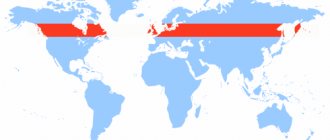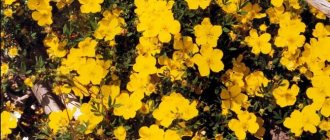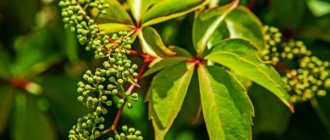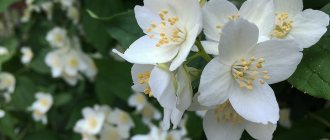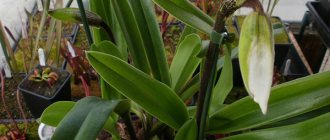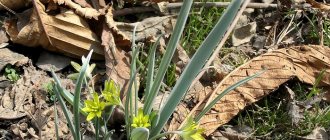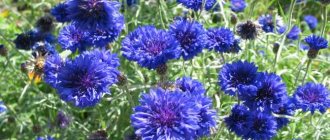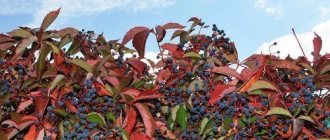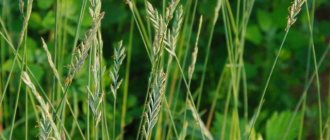Features of culture
Highlander is used for quick beautification of parks, flower beds and other objects. If agricultural practices are followed, the plant can reach a height of 3-5 m. External characteristics correspond to the popular name of buckwheat - Siberian bamboo. The trunk is wide, erect, smooth and hollow inside. The root system is powerful, wide, and deeply located in the soil.
The leaves of the knotweed are large and heart-shaped. The length and width of each reaches 30-35 cm. In summer they are painted in a rich emerald color, and by autumn they acquire a brownish-red hue. The size of the green mass is such that the surface of the growing soil is blocked from access to sunlight, which results in the absence of weeds in the planting area.
During the growing season, the upper part of the plant begins to branch, which leads to the formation of a dense, impenetrable hedge. A creeping vine entwines supports and walls of buildings, and masks the shortcomings of summer cottages.
The growing season begins in July and continues until mid-autumn. The flower stalks of the plant are numerous panicles with small inflorescences of white and cream shades. Knotweed is included among the productive honey plants.
Siberian bamboo is effectively used as a nutritious feed additive for cattle. The rich chemical composition is to the liking of many residents of Sakhalin - the plant is actively consumed as a dressing for soups and an ingredient in many salads.
Traditional medicine associates buckwheat with herbal preparations with anti-inflammatory and bactericidal effects.
Buckwheat in my flower garden
Today, when I was looking for photos of knotweed, I suddenly saw – my buckwheat ! That's right, him. I was quite surprised - it turns out that Japanese knotweed grows in my flower garden.
Buckwheat is not a bright flower, striking in beauty and striking with its impudence, like lupins. He is almost silent, almost invisible.
This is such beauty!
Where do the firewood come from?
Several years ago I brought a small sprout from Belokurikha, where this plant, somewhat reminiscent of bamboo due to its similar stems, also grows in a flower bed.
Although it cannot be called a flowerbed, it rather simply occupies the area under the windows of the city children's hospital. I fell in love with it immediately, and it’s no wonder: tall trunks and delicate clusters of small white-cream flowers. It was towards the end of September, everything that could have already bloomed, and here are the flowers.
She asked the gardener and dug up a sprout. They even told me the name – buckwheat . Yes, a little similar. That's all. I didn't think about him anymore. I planted it and it’s growing, but the location was chosen poorly, and there’s nowhere to replant it yet. It just languishes, but it doesn’t seem like it, because I distribute the shoots every spring to everyone who wants it.
Article on the topic: Ginger - beneficial properties, description
How it grows.
It is a perennial, its roots are brittle and winter well. The entire aboveground part: both stems and leaves, dies. The first frosts begin and that’s it, there is no more subtle autumn beauty.
My experience says that he needs rich, well-fertilized lands. Maybe some growing manuals write differently, but in my poor soil and in a place where there is little snow in winter, it has never grown as powerful as in this photo. His height did not exceed 80 centimeters.
This is how huge it grows in Belokurikha.
The sprouts first appear similar to peony sprouts, they also have a reddish color, then this will pass. It doesn’t grow quickly for me, as if it knows that there is a lot of time until autumn.
Oh, what a pest you are...
Once I had decided what kind of plant I had, I decided to see what they wrote about it. I found a beautiful picture and opened the site. English-speaking.
And there they don’t sing the praises of my settler. In England the climate cannot be compared with ours, so in their conditions buckwheat grows powerful, strong and becomes harmful.
It turns out that buckwheat was brought to Britain around the mid-nineteenth century as an ornamental plant. Apparently, someone, like me, liked the subtlest beauty.
And he turned out to be the aggressor. In Great Britain, the Japanese knotweed has no natural enemies, so it stepped out of the flower beds onto the roadsides, onto the banks of canals, and began to interfere with work on the railway track.
They are trying to eradicate it, but it is not working. It is tenacious, like our knotweed and woodlice. Buckwheat is not treated with herbicides. Such attempts were also made, but after the death of the grass, the roots still remained in the soil and gave life to new plants.
Buckwheat stems grow so densely that they do not allow other plants to grow through it. It turns out that an alien from another part of the world is pushing the indigenous people onto reservations, into places that are completely unsuitable for them.
In such a jungle, a child can get lost, not just other plants.
Another environmental disaster.
It is believed that buckwheat spread because gardeners threw away excess or dead plants on wasteland and waste land. In principle, it’s not scary, well, the grass will rot and add humus to the soil. Who cares about this? But that's how the seeds spread.
It turns out that there are many such migrant plants that the owners planted in their flower beds. They were guests of the indigenous flora, but turned into malicious weeds. So, Japanese knotweed was called an invasive plant.
Invasion is the colonization of an organism by parasites. So it turns out that for the nature of Great Britain, buckwheat has turned into an invasive plant species.
Now I’m thinking about how to remember those to whom I gave this plant, To tell about him, about his aggressor essence.
Or maybe you shouldn't do this? Our winters are frosty; buckwheat has not been able to adapt to my flower garden for five years now.
Buckwheat flowers have bird cherry melodies.
Types of Siberian bamboo
The total number of known species of knotweed reaches 300 representatives. The main part is found in the wild; 20 of them are suitable for cultivation.
All decorative buckwheat can be cultivated both in the southern regions and in the central climatic zone of Russia.
| View | Peculiarities |
| Aubert | An erect plant reaching 40 cm in height. The perianth is pink, the petals are white. Exudes a pleasant aroma |
| Baljuan | Knotweed, which has the structure of a finely leafed vine, suitable for growing in areas with harsh winters |
| Alpine | Found in the mountain steppes of the Northern Hemisphere. Small-leaved representative with a meager volume of flowering and a powerful, creeping root system |
| Candle-shaped | A remontant species with a long growing season. The shades of the inflorescences are pink-violet. Used for making dry bouquets and decorative compositions |
| Weiricha | A wild representative growing in the fertile soils of Japan. Winter-hardy and easily tolerates drought. Long-lasting flowering, up to six months |
| Oriental | It is found in India, has an average height (up to 2 m), and has a red tint to the petals. |
| Related | A dwarf species (up to 25 cm), which came from Nepal. Rosettes are small, brown in color |
The benefits of Sakhalin knotweed include the absorption of toxins contained in the soil, as well as the natural deoxidation of the soil.
Description
A common unifying feature for all types of knotweed is the structure of the stem, which has numerous bends and nodes. The stems of knotweed can be erect, creeping or climbing. The stems are densely covered with simple-shaped leaves on elongated petioles.
The roots of most plant species are well developed and creeping. There are species with a tap root system.
Polygonum flowers are miniature (white, pink or red), growing at the top of the stem, collected in racemes, paniculate or spike-shaped inflorescences. The knotweed bushes are abundantly covered with flowers, from May until the coldest weather. The seeds of the plant are enclosed in fruits - small dark nuts.
Kinds
- Related Highlander - a widespread garden flower. Forms dense curtains, no more than 30 cm high. The foliage is bright green, collected in rosettes, lanceolate in shape. Pink flowers are in spike-shaped inflorescences, 8 cm long; after blooming, they darken, becoming crimson. Varieties: Darling Red (deep pink-crimson flowers) and Donald Londes (pink-red inflorescences).
Related
- The amphibious knotweed is used to decorate the banks of natural and artificial reservoirs. The aquatic form of knotweed takes root at a depth of 10–14 cm; stems and narrow leaves float on the water surface. Light pink spikelets, consisting of small flowers, stick out 5 cm from the water, like small bright candles.
- Alpine mountainc grows up to a meter in height, forming a lush bush, with elongated (up to 12 cm) emerald foliage. Paniculate inflorescences of white or yellow hue.
Alpine
- Bluebell knotweed grows up to 90 cm, forming dense and dense thickets. It is distinguished by abundant and attractive blooming of pink flowers that look like bells.
- Capitate knotweed is a dwarf plant, up to 12 cm high. The clumps reach 30 cm in diameter. Pink flowers are collected in inflorescences - balls.
Capitate
- Candle-shaped . The plant, native to the foothills of the Himalayas, forms meter-long lush bushes. The foliage is elongated, bright green in summer, turning golden in autumn. Inflorescences in the form of a spike, rich scarlet color, appear in July and remain decorative until September. Varieties: Album (white flowers), Roseum (pink), High soseti (raspberry), Inverleith (miniature knotweed with red flowers).
- Twice twisted. An unpretentious and quickly growing plant, reaching a height of half a meter. Pointed narrow leaves are concentrated in basal rosettes, the stems are bare. Cream or pinkish flowers are collected in small spikelets. Double twisted knotweed is an excellent honey plant and medicinal plant.
Twice twisted
- Variable knotweed is an Asian variety that is very popular among gardeners. The abundantly flowering bush grows up to 200 cm in height and up to 150 cm in diameter. The stems of the flower are erect, densely leafy, crowned with paniculate large white inflorescences. Variable knotweed blooms for more than 50 days in July–August, spreading a strong honey aroma.
- Bird's knotweed (knotweed) is a medicinal annual plant, widely distributed in fields and meadows of the temperate zone of the Northern Hemisphere.
It is considered a weedy unpretentious plant. Knotweed is valuable as a feed (its nutritional value is equal to that of legumes); a decoction of the herb is used to rinse hair to improve growth and is used as a fabric dye. In medicine, it is widely used for hypertension, tuberculosis, inflammation of the kidneys, stomach and intestines, and liver diseases.
You can get acquainted with the appearance of the plant from the presented photos of the knotweed.
Plant propagation
To obtain planting material for Siberian bamboo, you can use several effective methods that a novice gardener can implement.
| Way | Planting period | Process description |
| Seminal | It is carried out by sowing in open ground in the fall or by seedling method in February-March | A period of stratification in the cold is required - at least 2-3 weeks. Afterwards, the seeds are placed in the soil to a depth of 2-3 cm. Germination occurs at temperatures above +20. The seedling method involves picking into individual containers at the stage of two leaves |
| Cuttings | In the spring after bud formation or early autumn | A part of the shoot that has 3 or more growth points is cut off. The cutting is placed in water at room temperature and transferred to open ground conditions as the rudiments of the root system appear |
| Dividing the bush | Autumn | The young shoot, separated from the root of the mother plant, is detached and transplanted to a permanent place |
| Digging in the shoot | Spring, autumn | A healthy, young shoot is selected, leaned against the ground and secured with a pin. As necessary, sprinkle with earth and periodically moisten. At the first signs of rooting, the seedling can be separated from the adult plant |
Reinnutria to cleanse the soil of toxins
According to numerous studies conducted by world-famous Japanese scientists, rheunutria has a unique ability to extract heavy metal salts and other toxic substances from the soil, neutralizing them during the growing season.
It is this quality of the plant that is actively used in Japan for the reclamation of land contaminated by industrial waste . There, knotweed is specially planted in places where there used to be garbage dumps, as well as areas saturated with toxic substances.
In our area, it is advisable to use this feature of Siberian bamboo in garden plots laid out in places with suspected presence of harmful substances in the soil, for example, on waste land or located near highways, industrial facilities, and chemical plants.
The photo shows young sprouts of rheunutria in early May. Delicious!
Choosing a landing site
Bamboo has no growing site preferences other than basic soil nutrient requirements. The plant grows well in the shade and in areas exposed to direct sunlight. The intensity of flowering of the knotweed depends on the length of daylight, but the general decorative qualities of both the shrub and the vine are not reduced.
Experienced gardeners joke that growing a crop is easier than destroying a mature hedge.
Future planting should be sufficiently distant from vegetable, fruit and berry crops. This measure is necessary to preserve the quantity and quality of the crop, which can die under the influence of the powerful knotweed, which has a depressing effect on any neighbor.
Caring for the Highlander
A pleasant feature of the knotweed is the absence of difficulties in caring for the plant. The shrub will grow on its own, without the intervention of the gardener.
However, in order to prevent disorderly growth and filling of a land plot with a limited area, it is necessary to take measures to form the crown of the hedge. Pruning is done throughout the season. Highlander easily tolerates mechanical stress and quickly restores its strength. Getting rid of excess green mass allows you to maintain the design of the site and provokes vigorous flowering.
Feeding measures are carried out in the first year of the crop’s life. It responds favorably to the addition of humus, herbal compost and rotted foliage of fruit trees to the soil. Young seedlings require frequent watering; an adult plant can be satisfied with the volume of natural precipitation. There is a need to control the growth of the root system, which consists in the timely removal of new shoots.
Advantages and disadvantages of a flower
One can argue endlessly about the advisability of growing a cultivated flower that has the character and properties of a weed. A summer resident who is at a crossroads regarding the purchase of Sakhalin knotweed planting material should study both sides of the coin.
The benefits of the plant include:
- Rapid growth, promoting rapid greening of the site.
- Attractive green mass.
- Ability to cover any support.
- Exquisite bloom.
- No difficult maintenance measures.
- Pharmaceutical and gastronomic qualities.
- Immunity to diseases and insect pests.
- High honey-bearing properties, etc.
There are also a number of disadvantages:
- Disorderly growth of shoots and root layers.
- The danger of proximity to vegetable crops, which will be deprived of moisture and nutrients.
- Creation of a dense shadow curtain and stagnation of water on the soil surface.
- Extreme survivability during disposal measures.
Application area
In addition to the fact that knotweed is a beautiful ornamental plant, it is also considered a very valuable vegetable crop. People use its leaves and young shoots for food. The leaves have a sour and pleasant taste, and they are also very juicy. They can be added as an additional component to various salads, prepare delicious soups, and also make filling for pies. Sakhalin knotweed is valued because it grows young greenery very early. Its content and taste, as well as the presence of vitamins, are very similar to sorrel and rhubarb; knotweed can easily replace them while these plants are not available.
Various birds, rabbits and livestock eagerly eat the leaves of the Sakhalin knotweed. But it is not recommended to abuse it. This food is rich in many vitamins, but at the same time it contains a lot of oxalic acid, and this can harm the health of animals.
You can also use it like this:
- For making compost, which can also be useful. Compost is prepared in the usual way, but when using such fertilizer, chalk or lime must be added to reduce acidity.
- Last year's mature stems can be used to make good supports for peas or other plants.
- The hollow stems can be used to make bases for a warm bed.
Sakhalin buckwheat , which impresses with its power, is a perennial. She can become:
- a valuable additive to human and animal diets;
- a wonderful ornamental plant that will decorate any area;
- very aggressive weed.
What this plant will become on your plot of land depends only on you.
How to destroy Sakhalin knotweed
To get rid of a fast-growing perennial, you need to undergo a number of difficulties. An overgrown root system can encircle not only the territory of its own growth area, but also involve nearby household plots in the development, which is fraught with problems in communicating with neighbors in the country.
The changeable nature of the plant can turn a flowering crop into a weed in the shortest possible time, so periodic intervention is necessary to stop disorderly growth and reproduction - merciless pruning of stems and digging up root cuttings.
If the presence of the knotweed becomes a painful phenomenon, relief measures should be taken:
- The physical method involves carefully uprooting mature plants, followed by hand picking over all yielding root stems. Even the smallest piece remaining in the soil is viable.
- Chemical method. Specialized herbicides are used to treat the surface part of the bush. The drug Agrokiller has good recommendations, which, according to gardeners, copes with the difficult task of fighting against Siberian bamboo.
Summary
Each summer resident decides for himself what the Siberian knotweed is - whether it is a malicious aggressor and a restless invader, a valuable element of landscape design, a feeder for herbivores, or a source of tasty shoots for preparing delicious and healthy dishes. Carefully read the information about all the features of the crop before acquiring an exotic plant and risking growing it in your dacha.
If you have experience using knotweed in cooking, share your favorite recipes in the comments, and if you are an opponent of bamboo, then tell us how you managed to free your plantations from the malicious weed.
Mila Nabogova, only for zakustom.ru
